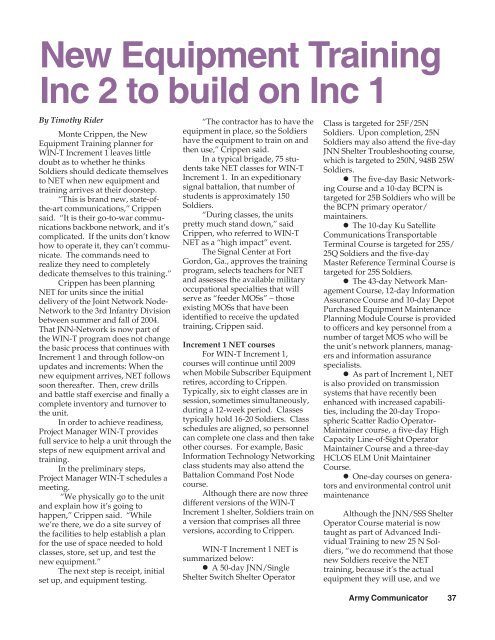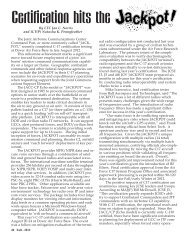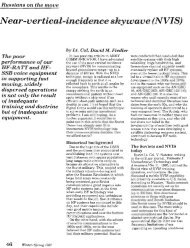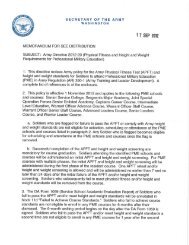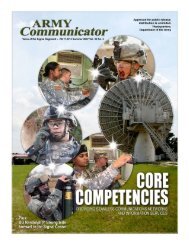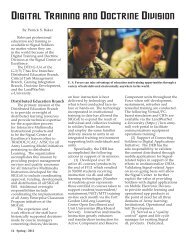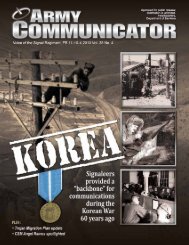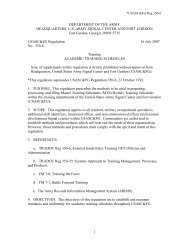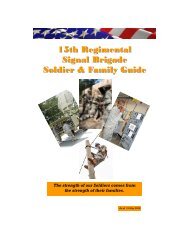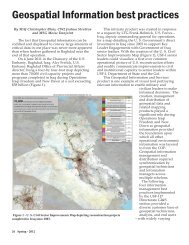AC Summer 08 WIN-T Online - United States Army Signal Center of ...
AC Summer 08 WIN-T Online - United States Army Signal Center of ...
AC Summer 08 WIN-T Online - United States Army Signal Center of ...
Create successful ePaper yourself
Turn your PDF publications into a flip-book with our unique Google optimized e-Paper software.
New Equipment Training<br />
Inc 2 to build on Inc 1<br />
By Timothy Rider<br />
Monte Crippen, the New<br />
Equipment Training planner for<br />
<strong>WIN</strong>-T Increment 1 leaves little<br />
doubt as to whether he thinks<br />
Soldiers should dedicate themselves<br />
to NET when new equipment and<br />
training arrives at their doorstep.<br />
“This is brand new, state-<strong>of</strong>the-art<br />
communications,” Crippen<br />
said. “It is their go-to-war communications<br />
backbone network, and it’s<br />
complicated. If the units don’t know<br />
how to operate it, they can’t communicate.<br />
The commands need to<br />
realize they need to completely<br />
dedicate themselves to this training.”<br />
Crippen has been planning<br />
NET for units since the initial<br />
delivery <strong>of</strong> the Joint Network Node-<br />
Network to the 3rd Infantry Division<br />
between summer and fall <strong>of</strong> 2004.<br />
That JNN-Network is now part <strong>of</strong><br />
the <strong>WIN</strong>-T program does not change<br />
the basic process that continues with<br />
Increment 1 and through follow-on<br />
updates and increments: When the<br />
new equipment arrives, NET follows<br />
soon thereafter. Then, crew drills<br />
and battle staff exercise and finally a<br />
complete inventory and turnover to<br />
the unit.<br />
In order to achieve readiness,<br />
Project Manager <strong>WIN</strong>-T provides<br />
full service to help a unit through the<br />
steps <strong>of</strong> new equipment arrival and<br />
training.<br />
In the preliminary steps,<br />
Project Manager <strong>WIN</strong>-T schedules a<br />
meeting.<br />
“We physically go to the unit<br />
and explain how it’s going to<br />
happen,” Crippen said. “While<br />
we’re there, we do a site survey <strong>of</strong><br />
the facilities to help establish a plan<br />
for the use <strong>of</strong> space needed to hold<br />
classes, store, set up, and test the<br />
new equipment.”<br />
The next step is receipt, initial<br />
set up, and equipment testing.<br />
“The contractor has to have the<br />
equipment in place, so the Soldiers<br />
have the equipment to train on and<br />
then use,” Crippen said.<br />
In a typical brigade, 75 students<br />
take NET classes for <strong>WIN</strong>-T<br />
Increment 1. In an expeditionary<br />
signal battalion, that number <strong>of</strong><br />
students is approximately 150<br />
Soldiers.<br />
“During classes, the units<br />
pretty much stand down,” said<br />
Crippen, who referred to <strong>WIN</strong>-T<br />
NET as a “high impact” event.<br />
The <strong>Signal</strong> <strong>Center</strong> at Fort<br />
Gordon, Ga., approves the training<br />
program, selects teachers for NET<br />
and assesses the available military<br />
occupational specialties that will<br />
serve as “feeder MOSs” – those<br />
existing MOSs that have been<br />
identified to receive the updated<br />
training, Crippen said.<br />
Increment 1 NET courses<br />
For <strong>WIN</strong>-T Increment 1,<br />
courses will continue until 2009<br />
when Mobile Subscriber Equipment<br />
retires, according to Crippen.<br />
Typically, six to eight classes are in<br />
session, sometimes simultaneously,<br />
during a 12-week period. Classes<br />
typically hold 16-20 Soldiers. Class<br />
schedules are aligned, so personnel<br />
can complete one class and then take<br />
other courses. For example, Basic<br />
Information Technology Networking<br />
class students may also attend the<br />
Battalion Command Post Node<br />
course.<br />
Although there are now three<br />
different versions <strong>of</strong> the <strong>WIN</strong>-T<br />
Increment 1 shelter, Soldiers train on<br />
a version that comprises all three<br />
versions, according to Crippen.<br />
<strong>WIN</strong>-T Increment 1 NET is<br />
summarized below:<br />
� A 50-day JNN/Single<br />
Shelter Switch Shelter Operator<br />
Class is targeted for 25F/25N<br />
Soldiers. Upon completion, 25N<br />
Soldiers may also attend the five-day<br />
JNN Shelter Troubleshooting course,<br />
which is targeted to 250N, 948B 25W<br />
Soldiers.<br />
� The five-day Basic Networking<br />
Course and a 10-day BCPN is<br />
targeted for 25B Soldiers who will be<br />
the BCPN primary operator/<br />
maintainers.<br />
� The 10-day Ku Satellite<br />
Communications Transportable<br />
Terminal Course is targeted for 25S/<br />
25Q Soldiers and the five-day<br />
Master Reference Terminal Course is<br />
targeted for 25S Soldiers.<br />
� The 43-day Network Management<br />
Course, 12-day Information<br />
Assurance Course and 10-day Depot<br />
Purchased Equipment Maintenance<br />
Planning Module Course is provided<br />
to <strong>of</strong>ficers and key personnel from a<br />
number <strong>of</strong> target MOS who will be<br />
the unit’s network planners, managers<br />
and information assurance<br />
specialists.<br />
� As part <strong>of</strong> Increment 1, NET<br />
is also provided on transmission<br />
systems that have recently been<br />
enhanced with increased capabilities,<br />
including the 20-day Tropospheric<br />
Scatter Radio Operator-<br />
Maintainer course, a five-day High<br />
Capacity Line-<strong>of</strong>-Sight Operator<br />
Maintainer Course and a three-day<br />
HCLOS ELM Unit Maintainer<br />
Course.<br />
� One-day courses on generators<br />
and environmental control unit<br />
maintenance<br />
Although the JNN/SSS Shelter<br />
Operator Course material is now<br />
taught as part <strong>of</strong> Advanced Individual<br />
Training to new 25 N Soldiers,<br />
“we do recommend that those<br />
new Soldiers receive the NET<br />
training, because it’s the actual<br />
equipment they will use, and we<br />
<strong>Army</strong> Communicator 37


